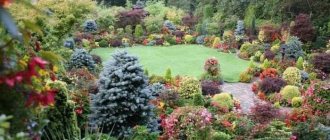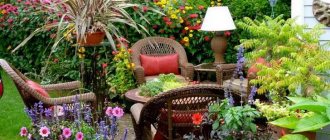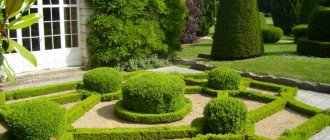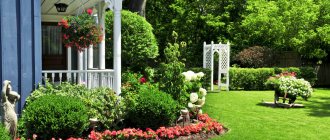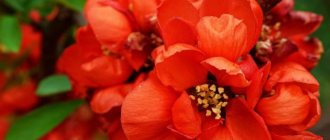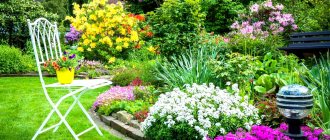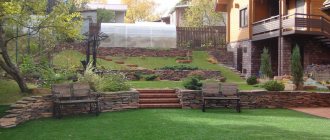Coniferous plants are often indispensable for landscape design. An easy-to-maintain green garden decoration will look great all year round and purify the air. Compositions from coniferous plants are easy to combine with other elements; you can add shrubs, stones and even flowers.
Despite the fact that in nature we have only a few species of conifers, due to introduced species, and even more due to the selection of ornamental varieties, the market offers a choice of hundreds of plants that are resistant to our climate. Therefore, everyone, if desired, can create a corner of harmony on their site to their own taste.
Secrets of creating perfect compositions
Conifers in the landscape design of small areas are often chosen among dwarf varieties. Small plants are compact and do not clutter up the area, but they grow more slowly and therefore may command higher prices. Before buying plants, it is better to draw up a sketch in advance or order a project from us, calculate the required number of plants of each variety, taking into account the available area and the size of adult plants, prepare places for planting, and only then go to the garden center or nursery.
During landscape design, do not forget about the spatial composition; try to make sure that all the elements of coniferous and deciduous plants are combined in size and shape, and do not contradict the surrounding space. It is always easier, cheaper and better to follow existing natural conditions than to try to radically change them. If the neighboring forest grows mainly pine trees, then on your site, most likely, there will also be suitable conditions for them.
Not the last place when drawing up a plan should be occupied by the color scheme - many conifers used in landscape design differ significantly in tone. The palette is varied - there are plants of pale light green, rich green, yellow, blue and other colors. At the same time, the color of the plant changes with the season. Young growths usually look the brightest. If you are thinking over a composition that will include three elements, use no more than two colors. The maximum for a composition of five elements is three colors. In the case of large-scale projects using different breeds over large areas, it is better to separate groups by color to avoid disharmonious combinations.
Harmonious color combination
Much depends on your goals. If the task is simply to decorate the area and try your hand at a new business, then it is better to start with a small project - for example, a flower bed or an alpine slide. Many gardeners choose coniferous trees to create a hedge to separate the area from the neighboring area, extraneous sounds and dust. This way you can zone the space - for example, fence off a utility area or create a garden room. To replace the classic yew hedge, they use common spruce - a very popular option in Scandinavia and Finland, less often other types of spruce - Serbian, prickly. Western thuja hedges are very popular. It grows quickly and lends itself well to molding. Less commonly, hedges are grown from pine trees or junipers.
Coniferous hedge. Serbian spruce, then larch. In the foreground is the mountain pine “Pumilio”.
Creating a landscape design from coniferous plants with your own hands is a difficult but exciting task for beginners. Therefore, if you decide to try, then first study as much material as possible on this topic. Pay attention to one common mistake when conifers are called conifers. Conifers can probably be used in landscape design; but we would not recommend doing this, since growing conifers may fall under an article of the criminal code. Ephedra is a foliage narcotic plant. Don't confuse it with spruce ;)
Advice from experienced flower growers
Coniferous compositions are increasingly winning the hearts of flower growers. Most often, mixed flower beds are created. Mixborders made of shrubs, flowers and conifers look original at any time of the year.
Many flower growers, through their own experience, have identified patterns in growing compositions from coniferous plants, and share their observations with us.
- As a rule, coniferous plants are planted as the basis of the composition.
- Then decorative deciduous shrubs, perennial flowers and herbs are added to them.
- Plants are selected depending on location. Only sun-loving specimens are planted in the sun, and less demanding ones are planted in the shade.
- Conifers should not be planted close. As a result, they can grow greatly, interfering with each other. It will be difficult, even impossible, to plant them.
- Among evergreen specimens, dwarf pines, spruces, and thuja are chosen for flower beds. A flowerbed with thujas is a common design option for a garden plot.
- When planting evergreens, dig large holes, filling them with a nutrient mixture, because they grow in one place for a long time.
- Shrubs such as cinquefoil, hydrangea, mock orange, and spirea are added to conifers.
- Flowering perennials are also planted, for example, irises, peonies, roses, daylilies, astilbes, hosts, and heucheras.
- Be sure to add ground cover plants - saxifrage, thyme, bryozoan, subulate phlox, periwinkle.
- While perennial flowers are growing, annuals are added to the composition: petunias, violas, mumuluses, tulips, gypsophila, tigridia, muscari.
- Plant perennial herbs, such as lavender, in your flower garden.
In this video you will find interesting options for mixborders, compositions with conifers, beautiful rockeries and much more.
Designers and experienced flower growers who devote their free time to growing coniferous splendor, as a result, “infect” all lovers of beauty with this love. If you were touched by fabulous compositions and you are determined to learn a new hobby, then share with us in the comments.
Alpine slide
The Alpine slide is created according to the same principle - creating an imitation of the wild nature of the Alpine belt. Keeping the previous principle in mind, you can combine coniferous compositions in landscape design with other plants and stones. It is important not to fall into typical mistakes described in English literature of the 19th century, and not inadvertently make a “dog’s grave” or “raisin bun”.
Miniature alpine slide - rock garden in a stone trough (miniature rolling pin)
Try choosing a cascading structure to add a special charm to the area. It is important to arrange the parts so that large elements do not block smaller ones.
Heather
Heather is valued by gardeners for its decorative qualities. In nature, a highly branched, evergreen shrub is found in coniferous-deciduous forests and grows on mountain slopes, so it is no stranger to proximity to conifers.
Selection of plants for a coniferous composition
When you see a coniferous garden in a photo, it seems that creating your own composition will not be difficult, but the first problems arise almost immediately - when choosing plants.
Choosing conifers is not an easy task
In a small garden, you should not use seedlings of wild spruce and pine trees - it will be difficult to keep them compact, and they will quickly reach their characteristic height and diameter, taking up almost the entire space on the site.
Choose compact plants that have been specifically bred for landscape design, because their growth is not as active and will not negatively affect the composition in the future. This will require special literature and catalogs published by large nurseries or industry associations. The most complete catalog in Russia is published by the Association of Planting Material Producers of Russia, APPM.
Choosing the right plants is the key to success
All conifers can be divided into three groups depending on size:
- Tall growing . This group includes prickly spruce, which can reach 40 meters in height, Serbian spruce with a narrow crown, prickly spruce, including the blue form, Scots pine, Siberian pine (cedar), and pseudohemlock.
- Medium growing . Western thuja and its varieties “Brabant”, “Smaragd” and others, Scots pine “Norske Type”, mountain pine, columnar juniper, some varieties of prickly spruce.
- Undersized . An array of mountain pine “Pumilio”, common spruce “Nidiformis” (nest-shaped form), common juniper “Repanda” (creeping form pressed to the ground), horizontal juniper, microbiota (“Russian cypress” native to the Far East) can look impressive on the site. .
Barberry, spirea and other shrubs
Not only flower beds, but also deciduous shrubs can create a good-natured neighborhood for junipers, thujas and pines. At the beginning of summer, the rich color of conifers will become a noble background for the lush inflorescences of lilac, hydrangea, spirea, and barberry. By the beginning of autumn, the reddened and yellowed foliage will sparkle with the greenery with new colors, and the flowerbed will not lose its attractiveness.
To ensure that cedars, pines and spruces fit into the landscape of the site, take inspiration from nature. The most natural composition, close to a forest or mountain landscape, will always be interesting and harmonious.
Subtleties of planting and care
Before planting a tree or shrub, consider that it will need more space in the future, so leave room to spare based on the size of the mature plant. If the diameter of an adult shrub is, for example, three meters, then this is the minimum area that must be allocated for this variety . Several smaller seedlings can be planted in this area, which will quickly close their crowns and cover the ground.
It is important to leave enough space for conifers to grow. The planting density and size of the clumps is determined both by the dimensions of adult plants and the size of seedlings.
Most species require minimal care - systematic watering in the initial period and during drought, weeding, the soil must be loosened and fertilized in a timely manner. You can pinch young shoots to form a crown.
Follow simple but important rules:
- Under no circumstances should the root collar be allowed to go deep. It is necessary to check whether it is buried during the packaging of the plant in the nursery. You need to find the main, skeletal thick roots. The top of the roots extending from the trunk, like the spokes of a wheel, should be located at the level of the top of the soil.
- Mulch the plantings with crushed bark, wood chips or pine needles 4–5 cm thick, without covering the root collar.
- When you combine tall and short plants, achieving harmony can be difficult. To avoid a feeling of clutter, do not choose plants of many types and colors. It is better to use one or two species, or varieties, but in large quantities, than to plant the entire range of the garden center on the site.
- Try playing with geometry by combining different shapes - for example, spherical and pyramidal plants.
The ideal time for planting is spring after the soil has thawed or from late summer to early autumn. In mid-summer you can plant conifers on the site, but it is better to avoid hot periods. It is better to mark planting sites in advance using pebbles or pegs. In this case, it is important to prepare the planting holes and soil - mix the soil with peat and sand. The recipe for the soil mixture depends on the available soil; you can dilute it with sand and peat.
Most conifers prefer well-drained soils, so in areas with heavy, clayey soils you will have to make large planting holes with lighter soil and lay drainage for the bases of the planting holes and pit, leading it into a drainage system or ditch.
Look at the trees growing naturally on and near your property. If these are pine trees, then the soils are most often sandy and light; Spruce trees tolerate dry soil less well.
Newly planted dwarf cedar (Pine pine) and Scots pine (in the background).
When planting a plant with a clod of soil in burlap and netting, after placing the seedling in place in the hole, cut the top of the netting and untie the burlap, find the main roots and make sure that the root collar is not buried. After this, remove the mesh from the top of the ball, fill it with soil around the ball, and spill it with water. Add soil again and compact it with your foot.
When planting a plant from a container, also make sure that the root collar is not buried and that the roots are not curled. If necessary, remove the soil to the level of the root collar, and all small roots that may have grown around the trunk above the main roots. Roots tightly twisted along the walls of the container are a defect; it is better not to take such plants; but cut the top layer with a sharp knife in four to five places, vertically.
After planting, it is better to mulch the tree trunk or the entire clump (chopped bark, wood chips, cones or pine needles are used as mulch, depending on what is available and what is convenient to use). Mulch helps retain moisture, maintain soil life, and discourage weed growth. The thickness of the mulch should be sufficient, at least four centimeters. After planting, water the plants regularly, especially in hot weather. However, you should not overwater them, especially in heavy soil. Roots, first of all, require oxygen, and they should not be allowed to soak for long periods of time. The plant may die.
There is an excellent signal that will help you understand that thujas, ornamental spruces and junipers feel great in a new area - this is the appearance of new growths. Coniferous plants grow actively in central Russia and the North-West in late spring - early summer, then the growth of shoots stops. The second wave of growth, much weaker, occurs in August. Plants need to be planted so that they do not interfere with each other.
Photos and diagrams
The choice of plants, their quantity and combination depends on the size and location of the space that is planned to be allocated for planting ornamental crops on the site.
Mixborders
Mixborder is a complex rectangular flower garden that blooms continuously throughout the season. Its width should not exceed the height of the tallest plant.
Translated from English, mixborder means “mixed border” (mix – “mix” and border – “border”, “border”).
A dwarf pine, two barberry bushes, rock juniper, spirea and hosta planted in a row - although not a full-fledged mixborder, it looks beautiful.
This composition can take place near the fence, against the backdrop of a gazebo, or a bathhouse.
A brighter version of the mixborder - with irises as the central element. The borders of the flowerbed are outlined by cypress and thuja, with spirea bushes and scaly juniper as the border.
Spiraea is notable for its long, abundant flowering and bright foliage color, which goes well with the greenery of the needles
Round and semicircular flower beds
A classic round flower garden can be made in front of the house, in the front garden, or in the garden. The option presented below is collected from shade-tolerant plants.
When planting, it is important to take into account the ability of this form of juniper to grow rapidly horizontally.
A semicircular flower bed with thujas, cypress, spirea and roses is placed in a sunny place or in light partial shade. To maintain the correct shape, a number of spirea bushes are regularly trimmed. You can simplify the task by planting only 3 spirea bushes at an equal distance from each other.
Regular trimming is required to maintain the clear contours of the spirea border.
An interesting option is a round flowerbed made of two parts - the outer hemisphere is formed by 4 spherical thujas, the circle is occupied by juniper, 2 heather bushes and hybrid tea roses
The spherical thuja "Danika" at the age of ten can reach 1 m in diameter and 0.5 m in height. It is unpretentious, tolerates partial shade, but in the sun the needles become brighter and denser.
Corner design
A veranda attached to a house and outbuildings often form corners that remain empty. Such “inconvenient” spaces are best reserved for corner flower beds.
The tile surround and two-color mulching add additional decorativeness to the composition.
Framing garden paths
The path from the gate to the house on one or both sides can be decorated with dwarf junipers and thujas. The alternation of pyramidal and spherical shapes looks good. The spaces between them are usually filled with hostas, heucheras, primroses, chrysanthemum bushes, and bright flowering annuals.
Juniperus 'Blue Star', Heuchera 'Bella Note' and orange daylily form a stylish trio
Pine
Gardeners often choose pine trees for their unpretentiousness to climate and soil.
Pine seedlings
Pine seedlings in the nursery
Pines in the landscape design of the fourth and fifth climatic zones, which corresponds to the most populated territory of the middle zone and north-west, are used as follows: Scots pine, Scots pine “Norske Type”;
Surprising as it may seem, some varieties of very winter-hardy Scots pine growing in the Arctic Circle are not winter-hardy enough in St. Petersburg, including the “Votereri” variety.
- Mountain pine and its many forms and varieties (Pumilio, Mugus, Winter Gold, Pug and others);
- Rumelian pine (Balkan) with very long needles and large cones;
- European and Siberian pine;
- Korean pine, with very large edible nuts;
- dwarf pine (dwarf pine), reminiscent of mountain pine, but with edible pine nuts and bluer needles.
- The once popular Weymouth pines are highly susceptible to attack by rust fungi and are almost out of use.
Pine bonsai against the background of a coniferous hedge
Saxifrage
Another favorite companion for evergreens among landscape designers is garden saxifrage. Rocky, loose, well-drained soil is suitable for planting perennials.
Saxifraga is adjacent to dwarf species of conifers: fir, spruce, and pine. In flowerbeds with diffused light it grows quickly, forming a green carpet with star-shaped buds.
Spruce
This tree, typical of the middle zone, also does not require serious care. In landscape design, common spruce, Serbian spruce, and prickly spruce, which has a green and blue shape, and many decorative varieties are used. For large compositions, tall trees are used.
The blue spruce on the site is not necessarily the blue form of the prickly spruce. In Serbian spruce, due to the color of the underside of the needles, the overall color is also slightly blue.
Spruce on the site. Simple topiary made from Norway spruce
Other spruces are also used:
- Dwarf variety of Serbian spruce “Nana”;
- A spherical variety of prickly spruce with blue needles “Glauca globoza”;
- A narrow-clone variety of common spruce with weeping branches “Inverse”.
Smolevka
You can create a semblance of a mountain landscape on your site by experimenting with combining several coniferous shrubs in one flower bed. A scattering of stones and cushion-shaped and creeping flowers, such as gum, gives the landscape a complete look.
A bright blanket of small flowers adds color to the rock garden and looks natural and unobtrusive. The plant does not require special care and takes root well in sandy soils.
Thuja occidentalis
These trees, originally from the west coast of the United States, have long been naturalized in Europe, easily adapt to different conditions, and are not afraid of frost and city air. Easy care and a wide variety of crown shapes make them desirable guests in summer cottages.
Thuja occidentalis on the site
Plants easily fit into different compositions. Thuja makes dense hedges.
Yew hedge. Sissinghurst, UK
Hedges are great for defining green rooms in an area. This hedge of thuja occidentalis 'Brabant' separates the economic area with a vegetable garden from the residential part of the site
Cereals
Quite often in nature, cereals are found next to evergreen crops. You can also use this combination on your personal plot. Fescue, pogonaterum, setaria, pinnately bristle, and miscanthus add lightness and playfulness to flower beds. Cereals fit equally succinctly into rock gardens, alpine hills and flower beds framing ponds.
Despite their splendor, decorative ears and panicles do not block sunlight, so they are often accompanied by young seedlings of dwarf mountain pines and spruces. With the onset of frost, the cereals do not lose their splendor and continue to please the eye.
Juniper
A wide selection of junipers - although there are only a few species suitable for climate zones 4 and 5, they have developed varieties of different sizes and shapes, ranging from trees up to ten meters high, to creeping shrubs with a diameter of several meters, but a height of centimeters.
Juniper. Botanical Garden in Brno
Juniper has gray cones that are used to make gin.
Care instructions
Those who have carefully studied the descriptions of the species already know that minimal care is needed for conifers:
- Watering. Additional moisture is required only in the first couple of years after planting, after which the plant can feed on its own.
- Feeding. They apply it once every 2-3 years (the older they are, the less often), but they begin to fertilize from the second year of life in a permanent place.
- Mulching. A layer of sawdust, peat or bark will protect the soil from excessive evaporation of moisture, suitable for moisture-loving conifers.
- Trimming. Not all varieties need pruning: mainly dwarf or creeping species should be pruned. This is done once a year, the most favorable time is March. Sanitary pruning is carried out as necessary, removing dried branches.
Yew
The yew is the only native conifer in the UK and is associated with perfectly trimmed hedges and free-standing dark conifers. Unfortunately, winter-hardy yew species are very difficult to find, and most yews from Europe do not winter well in our country .
Yew berry, hedge at Sissinghurst
Rules for caring for the composition
- At the beginning of spring, you need to remove all covering material from the rock garden, remove broken branches, add fresh soil, plant annual flowers, apply fertilizer, mulch and water.
- In summer, plants need to be regularly watered and sprayed, weeds removed, crowns formed, and treated with insecticides and slug repellents.
- In the fall, it is necessary to remove all annual plants, renew the mulch, fertilize the soil, cover everything with film or spruce branches, which can be laid on top of geotextiles.
- In winter, in severe frosts, you can cover the alpine slide with snow and make sure that the covering material remains in place.
Beauty secrets
How to protect plants from sunburn and freezing? On the one hand, it is important to choose a place that ideally suits all their tastes and whims, and on the other, to carry out agrotechnical measures that at the beginning of the season will help cope with the consequences of the stress experienced in winter. Before spreading coniferous plants around the site, carefully study their tastes and requirements
Choosing the right place
Before spreading coniferous plants around the site, carefully study their tastes and requirements. Yew trees are the most shade-tolerant members of the “thorny company”; you can leave the most secluded corners for them. Decorative forms of common juniper grow well in partial shade, which means they will like the proximity to taller shrubs, but rock juniper feels good only in the open sun, choose the most illuminated areas for it.
Raising immunity
In the spring, spray the prickly beauties and beauties with aqueous solutions of drugs that reduce stress and increase immunity (Epin or Zircon). Important : such an event can only be carried out at positive air temperatures. And in early autumn, do not forget to feed your pets with phosphorus-potassium fertilizers (20-40 g under the tree trunk or under a bush), which should be evenly distributed over the surface, embedded in the soil and then watered.
Let's shout!
The secret of the attractiveness of the narrow and pyramidal shape of the crown is not difficult to explain; it is precisely such silhouettes that can solve a wide variety of and not always simple tasks in the garden:
- On the one hand, they allow you to grow tall trees in small gardens , where there is no room for spreading crowns.
- On the other hand, such plants are used to create a visual barrier in those parts of the garden where it is necessary to block the view. This is especially true for creating secluded corners for relaxation or concealing business facilities.
- And finally, they provide reliable protection from the wind both for vacationing owners and their guests, and for delicate heat-loving plants.
In garden design, coniferous verticals are used in single plantings, in groups, in hedges, in shrub mixborders and as part of compositions with herbaceous perennials.
In garden design, coniferous verticals are used in single plantings, in groups, in hedges, in shrub mixborders and as part of compositions with herbaceous perennials. In the latter case, such an object becomes the dominant one - the central link around which the entire composition is tied. Important: spectacular and at the same time simple-to-execute “companies” can be easily created from three to five plants, different in height, but representing the same species and variety.
Spectacular and at the same time simple in execution companies can be easily created from three to five plants, different in height, but representing the same species and variety
Single specimens can advantageously emphasize various architectural elements (for example, a column, arch or porch) or serve as focal points in the garden design, drawing attention to certain planning solutions. In the photo below :
- Left: a coniferous “cigar” at the edge of a green lawn helps make the garden landscape more voluminous and picturesque.
- In the center: a graphic, clear silhouette makes the coniferous columns very noticeable and attracts attention no less than garden sculptures.
- Right: resting geometry. The cozy bench is protected from the wind and prying eyes by a coniferous “wall”.
Left: a coniferous “cigar” helps make the garden landscape more voluminous and picturesque. In the center: a graphic, clear silhouette makes the coniferous columns very noticeable and attracts attention no less than garden sculptures. Right: a cozy bench is protected from the wind and prying eyes by a coniferous “wall.” You will learn how to create such a wall in the article 11 of the best coniferous plants for hedges.
